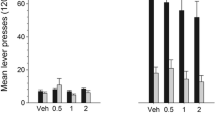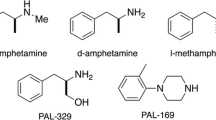Abstract
Rationale
Studies investigating dopamine D2 receptor antagonism of cocaine's discriminative stimulus effects have resulted in varied effects possibly due to the use of different antagonists, species, and procedures.
Objectives
The present study sought to further investigate D2 antagonism of cocaine's discriminative stimulus effects using a variety of D2 antagonists and multiple doses of the antagonists in combination with cocaine.
Methods
The benzamide D2 antagonists, eticlopride, raclopride, and sulpiride, and the butyrophenone D2 antagonists haloperidol and spiperone were administered alone and in combination with cocaine in squirrel monkeys trained to discriminate cocaine from saline under a fixed-ratio food reinforcement procedure.
Results
All the D2 antagonists, except haloperidol, antagonized the discriminative stimulus effects of the cocaine training dose. However, only the benzamide D2 antagonists produced significant rightward shifts in the cocaine discriminative stimulus dose–effect curve and they only did so within a narrow dose range and time after administration. In contrast, the D2 antagonists failed to antagonize the rate-suppressant effects of cocaine, and in some cases, cocaine appeared to antagonize the rate-suppressant effects of the antagonists.
Conclusions
The present results suggest (1) that D2 antagonism of cocaine's discriminative stimulus effects depends critically on the selected antagonist, antagonist dose, and time of administration, as well as how antagonism is assessed (i.e., in terms of effects on training dose or on the cocaine dose–effect curve), (2) that the maximal shift in cocaine's discriminative stimulus dose–effect curve possible with D2 antagonists under these procedures is ~two- to threefold, and (3) that different effects of cocaine are differentially sensitive to dopamine receptor antagonism.


Similar content being viewed by others
References
Achat-Mendes C, Grundt P, Cao J, Platt DM, Newman AH, Spealman RD (2010) Dopamine D3 and D2 receptor mechanisms in the abuse-related behavioral effects of cocaine: studies with preferential antagonists in squirrel monkeys. J Pharmacol Exp Ther 334:556–565
Anderson KG, van Haaren F (2000) Effects of SCH-23390 and raclopride on cocaine discrimination in male and female Wistar rats. Pharmacol Biochem Behav 65:671–675
Barrett RL, Appel JB (1989) Effects of stimulation and blockade of dopamine receptor subtypes on the discriminative stimulus properties of cocaine. Psychopharmacology (Berl) 99:13–16
Callahan PM, Cunningham KA (1993) Discriminative stimulus properties of cocaine in relation to dopamine D2 receptor function in rats. J Pharmacol Exp Ther 266:585–592
Callahan PM, Appel JB, Cunningham KA (1991) Dopamine D1 and D2 mediation of the discriminative stimulus properties of d-amphetamine and cocaine. Psychopharmacology (Berl) 103:50–55
Chausmer AL, Katz JL (2001) The role of D2-like dopamine receptors in the locomotor stimulant effects of cocaine in mice. Psychopharmacology (Berl) 155:69–77
Chausmer AL, Elmer GI, Rubinstein M, Low MJ, Grandy DK, Katz JL (2002) Cocaine-induced locomotor activity and cocaine discrimination in dopamine D2 receptor mutant mice. Psychopharmacology (Berl) 163:54–61
Costanza RM, Terry P (1998) The dopamine D4 receptor antagonist L-745,870: effects in rats discriminating cocaine from saline. Eur J Pharmacol 345:129–132
Costanza RM, Barber DJ, Terry P (2001) Antagonism of the discriminative stimulus effects of cocaine at two training doses by dopamine D2-like receptor antagonists. Psychopharmacology (Berl) 158:146–153
Filip M, Przegalinski E (1997) The role of dopamine receptor subtypes in the discriminative stimulus effects of amphetamine and cocaine in rats. Pol J Pharmacol 49:21–30
Finney DJ (1964) Statistical methods in biological assay, 2nd edn. Hafner, New York
Geter-Douglass B, Riley AL (1996) Dopamine D1/D2 antagonist combinations as antagonists of the discriminative stimulus effects of cocaine. Pharmacol Biochem Behav 54:439–451
Hillegaart V, Ahlenius S (1987) Effects of raclopride on exploratory locomotor activity, treadmill locomotion, conditioned avoidance behaviour and catalepsy in rats: behavioural profile comparisons between raclopride, haloperidol and preclamol. Pharmacol Toxicol 60:350–354
Jarbe TU (1984) Discriminative stimulus properties of cocaine. Effects of apomorphine, haloperidol, procaine and other drugs. Neuropharmacology 23:899–907
Jenner P, Marsden CD (1984) Multiple dopamine receptors in brain and the pharmacological action of substituted benzamide drugs. Acta Psychiatr Scand Suppl 311:109–123
Johanson CE, Barrett JE (1993) The discriminative stimulus effects of cocaine in pigeons. J Pharmacol Exp Ther 267:1–8
Katz JL, Kopajtic TA, Myers KA, Mitkus RJ, Chider M (1999) Behavioral effects of cocaine: interactions with D1 dopaminergic antagonists and agonists in mice and squirrel monkeys. J Pharmacol Exp Ther 291:265–279
Kleven MS, Anthony EW, Goldberg LI, Woolverton WL (1988) Blockade of the discriminative stimulus effects of cocaine in rhesus monkeys with the D1 dopamine antagonist SCH 23390. Psychopharmacology (Berl) 95:427–429
Kohler C, Ogren SO, Fuxe K (1984) Studies on the mechanism of action of substituted benzamide drugs. Acta Psychiatr Scand Suppl 311:125–137
Martelle JL, Claytor R, Ross JT, Reboussin BA, Newman AH, Nader MA (2007) Effects of two novel D3-selective compounds, NGB 2904 [N-(4-(4-(2,3-dichlorophenyl)piperazin-1-yl)butyl)-9H-fluorene-2-carboxami de] and CJB 090 [N-(4-(4-(2,3-dichlorophenyl)piperazin-1-yl)butyl)-4-(pyridin-2-yl)benzami de], on the reinforcing and discriminative stimulus effects of cocaine in rhesus monkeys. J Pharmacol Exp Ther 321:573–582
Meert TF, De Haes P, Aerts N, Clincke G (1996) Antagonism of the discriminative stimulus properties of cocaine with the combination of a dopamine D1 and D2 antagonist. Acta Neurobiol Exp (Wars) 56:897–905
Sinnott RS, Nader MA (2001) Modulation of cocaine's discriminative stimulus effects by dopamine D(1) agonists in rhesus monkeys. Pharmacol Biochem Behav 68:301–309
Snedecor GW, Cochran WG (1967) Statistical methods, 6th edn. Iowa State University Press, Ames
Spealman RD, Bergman J, Madras BK, Melia KF (1991) Discriminative stimulus effects of cocaine in squirrel monkeys: involvement of dopamine receptor subtypes. J Pharmacol Exp Ther 258:945–953
Vanover KE, Kleven MS, Woolverton WL (1991) Blockade of the discriminative stimulus effects of cocaine in rhesus monkeys with the D(1) dopamine antagonists SCH-39166 and A-66359. Behav Pharmacol 2:151–159
Witkin JM, Schindler CW, Tella SR, Goldberg SR (1991) Interaction of haloperidol and SCH 23390 with cocaine and dopamine receptor subtype-selective agonists on schedule-controlled behavior of squirrel monkeys. Psychopharmacology (Berl) 104:425–431
Acknowledgments
We are grateful for the expert technical assistance of Eric Adams in conducting these studies. These studies were supported by the Intramural Research Program of the Department of Health and Human Services, National Institutes of Health, National Institute on Drug Abuse.
Conflict of interest
None.
Author information
Authors and Affiliations
Corresponding author
Rights and permissions
About this article
Cite this article
Soto, P.L., Katz, J.L. Interactions of cocaine with dopamine D2-like antagonists in squirrel monkeys. Psychopharmacology 226, 393–400 (2013). https://doi.org/10.1007/s00213-012-2914-7
Received:
Accepted:
Published:
Issue Date:
DOI: https://doi.org/10.1007/s00213-012-2914-7




